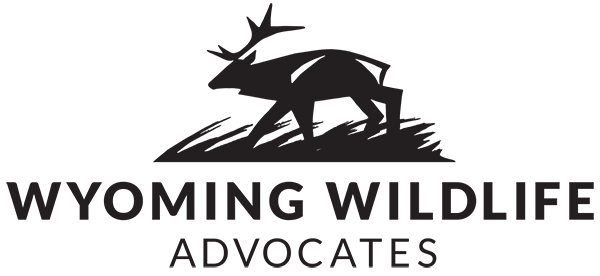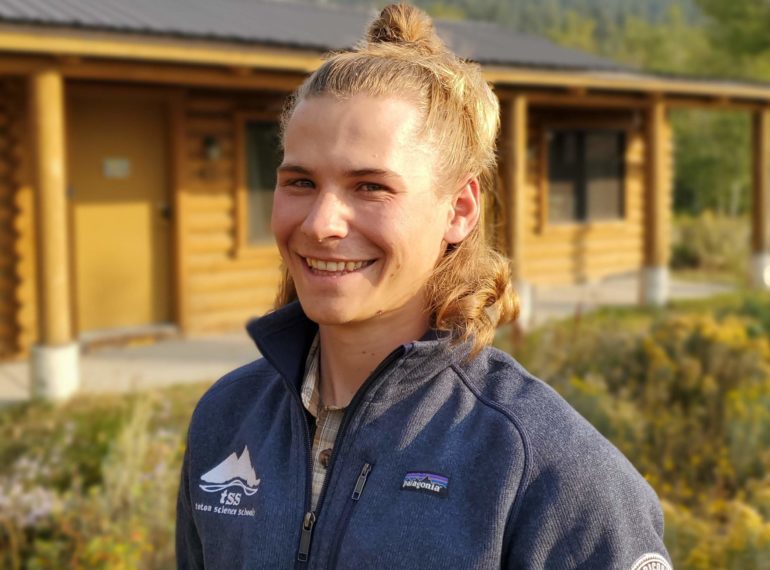We can’t begin to thank Grant Gallaher enough for his service to WWA this fall. Grant was with us from August through December and has even agreed to help out with the event we have on January 2 at the National Museum of Wildlife Art (NMWA) to roll out our Spanish edition of our wildly successful wildlife guides. Grant taught elementary school students about coexistence with bears and other wildlife, planned the NMWA event, developed a webpage and marketing materials for our TravelStorysGPS virtual tour, and helped with other important projects.
Grant hails from Spokane, Washington but has been lucky to call many places home over the years. Amidst the wheat fields of Walla Walla, he received a B.A. in Biology and Environmental Studies from Whitman College, with particular interests in ecology, biochemistry, and environmental justice. Grant followed his passions north to investigate climate change in the tide pools of Sitka, Alaska, and south to study tropical plants in the cloud forests of Ecuador. This past year, Grant taught English as a foreign language at a primary school on the small Spanish island of Menorca. As a kayak, climbing, and rafting guide, his most recent pursuits have brought him back home to share the Spokane River and other Inland Northwest waters with curious visitors from all over the world.
We recently sat down with Grant to get his thoughts on his time with WWA and where he’s hoping life will take him. Read all about Grant’s thoughts on AmeriCorps, conservation, and the future of wildlife management below. We are so grateful for Grant’s contributions and accomplishments during his term with us and we wish him all the best in the future!
1. What drew you to the AmeriCorps program?
I was drawn to the AmeriCorps program with Teton Science Schools because it gave me the opportunity to live in an ecologically and culturally unique location, surrounded by passionate individuals with similar interests, all the while building on my own passions for community environmental advocacy. In deciding to serve with Wyoming Wildlife Advocates and the Jackson Hole Conservation Alliance (my other community partner), I was attracted to both of these organizations because they didn’t seem afraid to push for policy changes on topics like large carnivores, community planning, or wildlife coexistence – topics that many others might deem too controversial or aspirational.
2. What is it about the Greater Yellowstone Ecosystem that interests you? Why did you choose this place to serve?
A middle-school field trip to Yellowstone National Park – led by a passionate, outside-the-box science teacher – cemented my early interests in the natural sciences. Returning to this ecosystem was full-circle for me, in a way. I came back to the GYE having learned much more about not only the workings of ecological systems, but also having gained some insight into the social, economic, political, and cultural systems with which they are interwoven. The GYE – in ways sometimes subtle, sometimes exaggerated – is home to all of the complexities of environmental (in)justice, political ecology, interspecies coexistence, and more that fascinate me about humanity’s relationship toward and within nature.
3. What have you learned about wildlife issues in Wyoming so far that has surprised you?
I was honestly surprised by the fact that Jackson and Teton County, Wyoming are, in many ways, not at the forefront of making progress on wildlife conservation issues like one might expect given the importance of wildlife in the region. Bear-proof trash cans, for example: why are they not yet required everywhere? (And requirements aside, why are they not voluntarily in use everywhere?) There are many ways to answer those questions that I don’t have time to get into here, but I think this points to the fact that Teton County, given the abundance of wildlife and wealth that exists here, could be leading the world on some of these issues and yet, for many reasons, is not.
4. What knowledge will you take with you from this experience that will help you in your career and/or conservation efforts?
This experience has greatly expanded my practical and theoretical knowledge-base that will help me as I continue to work in community environmental advocacy. Throughout my service, I have acted as an event planner, lesson instructor, social interviewer, community networker, blog writer, website designer, and much more. Each of these roles helped me develop skills that will certainly come in handy in future nonprofit work. On the ecological side, I deepened my understanding of issues surrounding bears, wolves, elk, and the GYE in general.
5. What has been the most rewarding part of your service?
A large portion of my service with WWA was dedicated to planning an event with the National Museum of Wildlife Art that aimed to be specifically welcoming and relevant to the local Latino/Hispanic/Spanish-speaking population that is the backbone of the Jackson community. I was able to use my Spanish-language background to network, build relationships, and organize food, music, and community artwork for the event. It was a tremendous pleasure to work with folks from the Children’s Learning Center, Teton Literacy Center, Voices JH, Our Lady of the Mountains, One22, and other local service organizations. There is a long way to go in terms of making wildlife advocacy and conservation work in this area relevant and beneficial to more diverse populations, but I am proud of making small steps toward bridging these segments of the community.
6. After learning about wildlife issues in Wyoming, what advice would you have for anyone who would like to get involved in educating themselves further?
Find people that have been in your community and thinking about these issues for longer than you have, and listen to their perspectives. Take those diverse ideas and combine them with your own thoughts and experiences to come up with something perhaps totally new. Trust and learn from their depth of experience, but don’t be afraid to interject with and stand behind what you believe.
7. What hope do you have for the future for wildlife conservation? Do you think humanity will be able to turn things around before many more species face extinction?
I believe that if we are to have hope for the future of wildlife conservation, it is found in the fact that all of the systems we currently live within were built by humans and therefore can be changed by humans. The relationship that most human individuals and institutions have with the planet and wildlife is not sustainable, and that manifests on scales small (bears euthanized for getting into unsecured trash) and large (global climate change). The dominant societal beliefs around growth, wealth, land, labor, and resources have not and will not lead to a harmonious relationship with wildlife. Our best hope is in collective action to change our systems, with the health and dignity of the land and non-human life at the center of our collective values and vision for human wellbeing.
8. Do you think there is hope that Wyoming will find a balance for wolves and grizzlies or do you think we are in for a few more decades of conflict?
Oof, tough question. First of all, see my answer to the question above. Second, I see hope in the passage of time and the changing of generations. When I taught programs on wildlife safety to 1st-5th grade students this fall, as kids got older, they already knew more and more about how they could be better neighbors to wolves, grizzlies, and all wildlife. As time passes, I hope that outdated attitudes and stories about large carnivores will fade, replaced by something that more holistically recognizes the interdependence of our existence with them. Translating those new stories into policy and actual change, however, is a whole other challenge. Again, collective action and organizing to challenge present imbalances of power and resources locally and globally may be the best chance we have.
9. What advice would you have for wildlife managers or students who are studying wildlife management currently?
The animals themselves are only one dimension; the human dimension(s) of wildlife management is where the real ballgame happens that most visitors to the GYE think significantly less about. “Human-wildlife conflict” is really rooted in conflicts of human beliefs about what our relationship with wildlife is and what it should be. If you want to be an effective manager, researcher, scientist, guide, tourist, or anything else related to wildlife, take time to learn about the politics, social dynamics, economic incentives, and general complexities that relate to wildlife. It’s all related. In Jackson, wildlife issues are directly and indirectly tied to ultra-wealth, a housing crisis, resource extraction, land zoning, systemic racism, immigrant exploitation, and, ultimately, power and privilege. Believe me, taking the time to dig into these extra dimensions of wildlife management will not make finding the solutions any easier, but it just might keep you on the track toward finding effective solutions, rather than putting band aids on centuries-old divisions. We’re only going to find those solutions by being bold enough to seek them together. Look deeper, think more critically, and don’t stop pushing for change that promotes dignity, health, and equity for all.
As Terry Tempest Williams writes: “Democracy demands we speak and act outrageously. We can change the world if our view is long and focused with friends drawn lovingly around the place we call home.”

